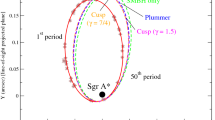Abstract
We study the effect of dark matter heating on the temperature of typical strange star (SS hereafter) (M = 1.4 M⊙, R = 10 km) in normal phase (NSS hereafter) and in a possible existing colour-flavour locked (CFL)phase (CSS hereafter). For NSS, the influence of dark matter heating is ignored until roughly 107 yr. After 107 yr, the dark matter heating is dominant that significantly delays the star cooling, which maintains a temperature much higher than that predicted by standard cooling model for old stars. Especially for CSS, the emissivity of dark matter will play a leading role after roughly 104 yr, which causes the temperature to rise. This leads to the plateau of surface temperature appearing in ∼106.5 yr which is earlier than that of NSS (∼107 yr).
Similar content being viewed by others
References
Witten E. Cosmic separation of phases. Phys Rev D, 1984, 30: 272–285
Farhi E, Jaffe R L. Strange matter. Phys Rev D, 1984, 30: 2379–2390
Alcock C, Farhi E, Olinto A. Strange stars. Astrophys J, 1986, 310: 261–272
Haensel P, Zdunik J L, Shaeffer R. Strange quark stars. Astron Astrophys, 1986, 160: 121–128
Colpi M, Miller J C. Rotational properties of strange stars. Astrophys J, 1992, 388: 513–520
Glendenning N K, Weber F. Nuclear solid crust on rotating strange quark stars. Astrophys J, 1992, 400: 647–658
Bailin D, Love A. Superfluidity and superconductivity in relativistic fermion systems. Phys Rep, 1984, 107: 325–385
Alford M G, Rajagopal K, Wilczek F. QCD at finite baryon density: Nucleon droplets and color superconductivity. Phys Lett B, 1998, 422: 247–256
Rapp R, Schäfer T, Shuryak E, et al. Diquark bose condensates in high density matter and instantons. Phys Rev Lett, 1998, 81: 53–56
Alford M G, Schmitt A, Rajagopal K, et al. Color superconductivity in dense quark matter. Rev Mod Phys, 2008, 80: 1455–1515
Cheng K S, Dai Z G. Chemical heating in strange stars. Astrophys J, 1996, 468: 819–822
Zheng X P, Yu Y W, Li J R. The effect of r-mode instability on the evolution of isolated strange stars. Mon Not R Astron Soc, 2006, 369: 376–382
Yuan Y F, Zhang J L. Cooling of a rotating strange star with a crust. Astron Astrophys, 1999, 344: 371–375; Yu Y W, Zheng X P. Cooling of a rotating strange star in the color superconducting phase with a crust. Astron Astrophys, 2006, 450: 1071–1075
Navarro J F, Frenk C S, White S DM. The structure of cold dark matter halos. Astrophys J, 1996, 462: 563–575
Ahmed Z, Akerib D S, Arrenberg S, et al. CDMS II Collaboration. Dark matter search results from the CDMS II experiment. Science, 2010, 327: 1619–1621
Aprile E, Alfonsi M, Arisaka K, et al. Dark matter results from 225 live days of XENON100 data. Phys Rev Lett, 2012, 109: 181301
Perez-Garcia M A, Silk J, Stone J R. Dark matter, neutron stars, and strange quark matter. Phys Rev Lett, 2010, 105: 141101
Kouvaris C. WIMP annihilation and cooling of neutron stars. Phys Rev D, 2008, 77: 023006
Iwamoto N. Neutrino emissivities and mean free paths of degenerate quark matter. Ann Phys, 1982, 141: 1–49
Gudmundsson E H, Pethick C J, Epstein R I. Neutron star envelopes. Astrophys J, 1982, 259: 19–23
Gudmundsson E H, Pethick C J, Epstein R I. Structure of neutron star envelopes. Astrophys J, 1983, 272: 286–300
Blaschke D, Klähn T, Voskresensky D N. Diquark condensates and compact star cooling. Astrophys J, 2000, 533: 406–412
Lattimer J M, van Riper K A, Prakash M, et al. Rapid cooling and the structure of neutron stars. Astrophys J, 1994, 425: 802–813
Cheng Q, Yu Y W, Zheng X P. Could strange stars be in the color-flavor-locked phase: Tested by their thermal evolutions. Phys Rev D, 2013, 87: 063009
Reisenegger A. Deviations from chemical equilibrium due to spindown as an internal heat source in neutron stars. Astrophys J, 1995, 442: 749–757
Watts A L, Andersson N. The spin evolution of nascent neutron stars. Mon Not R Astron Soc, 2002, 333: 943–951
Aldo T, Roberto T, Silvia Z, et al. Isolated neutron stars: Accretors and coolers. Publ Astron Soc Pac, 2000, 112: 297–314
Author information
Authors and Affiliations
Corresponding authors
Rights and permissions
About this article
Cite this article
Huang, X., Wang, W. & Zheng, X. Dark matter heating in strange stars. Sci. China Phys. Mech. Astron. 57, 791–795 (2014). https://doi.org/10.1007/s11433-014-5393-5
Received:
Accepted:
Published:
Issue Date:
DOI: https://doi.org/10.1007/s11433-014-5393-5



